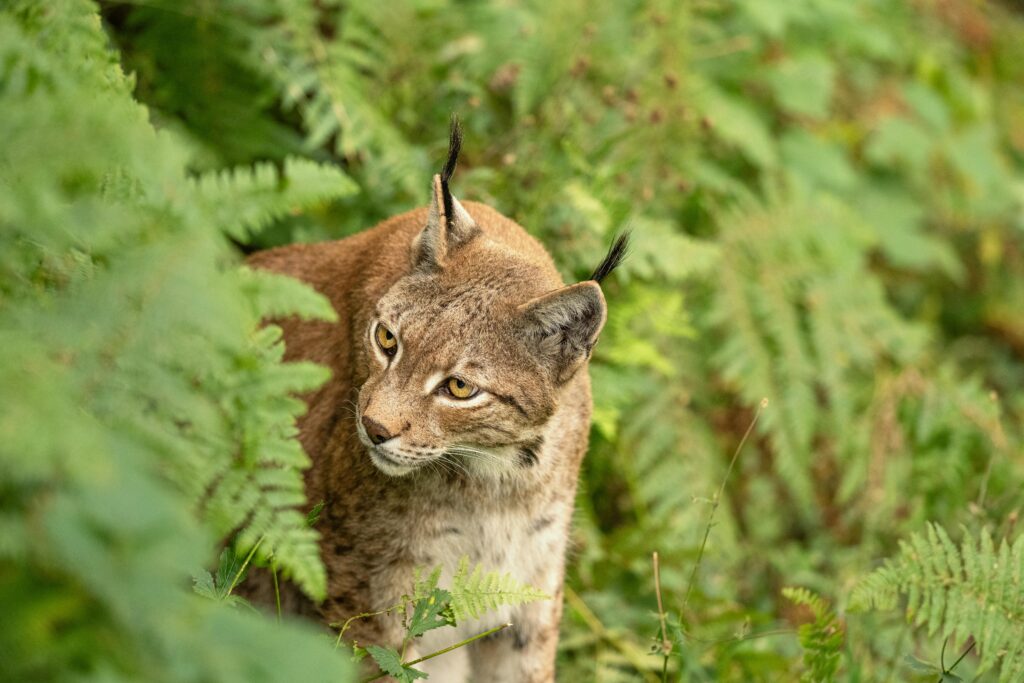Spain

Iberian Lynx Hunting
Spain may conjure images of beaches, cities, and festivals — but beneath that brightness lies a wilderness few expect. It’s in the rustle of cork oaks. The golden flicker of a lynx at dusk. The flight of vultures rising over sun-baked cliffs. Spain is wild, not because it’s untouched, but because something old still survives in its bones. In valleys where humans and nature have shared space for centuries, the wild remains — patient, beautiful, and fierce.
A Land of Survival and Return
Spain holds more biodiversity than any country in Western Europe. From alpine peaks to arid steppe, Atlantic coast to Mediterranean forest, each region shelters a different kind of life. But what makes Spain truly special is its resilience. This is a country where the Iberian lynx came back from the brink. Where vultures once vanishing now fill the sky. And where wildness exists not in spite of people — but, in many places, because of how they’ve lived alongside it for generations.
Where the Light Meets the Wild
Encounters in a Human Landscape
Unlike more remote wildernesses, Spain’s wildlife often lives among people. You may spot a lynx crossing a quiet road. Vultures circle above shepherds’ flocks. In oak groves used for grazing pigs, genets slip between the trees at night. It’s a wildness woven into daily life — not always obvious, but always there for those who take time to look.
Wild Icons of Spain
When to Visit for the Best Sightings
Spring (April–June) is alive with bird migration, wildflowers, and lynx cubs venturing out. Autumn (September–November) brings raptor migration, deer rutting, and clearer skies in the mountains. Winter offers the best chances to spot lynx in open terrain and to witness thousands of cranes resting in the central plains.
Threats and Hopes
Spain’s conservation story is one of both loss and redemption:
Final Reflections
Wildlife in Spain isn’t loud. It doesn’t happen all at once. It comes in flashes — a lynx crossing in twilight, a bear print in mud, the sudden shadow of wings overhead. It’s wildness that has endured, quietly, through centuries of change. And when you walk these landscapes — cork forest, limestone gorge, alpine ridge — you realize: Spain’s wild is not gone. It’s waiting. And it’s beautiful.
A Land of Survival and Return
Spain holds more biodiversity than any country in Western Europe. From alpine peaks to arid steppe, Atlantic coast to Mediterranean forest, each region shelters a different kind of life. But what makes Spain truly special is its resilience. This is a country where the Iberian lynx came back from the brink. Where vultures once vanishing now fill the sky. And where wildness exists not in spite of people — but, in many places, because of how they’ve lived alongside it for generations.
Where the Light Meets the Wild
- Doñana National Park: A shimmering mosaic of marshes, dunes, and Mediterranean scrub — home to imperial eagles, wild boar, flamingos, and the last stronghold of the Iberian lynx.
- Monfragüe National Park: A sanctuary for birds of prey — black vultures, Egyptian vultures, golden eagles, and griffon vultures circling monolithic cliffs in central Spain.
- Picos de Europa: Rugged, vertical, and green — where Cantabrian brown bears and wolves still roam high meadows and beech woods, hidden but present.
- Pyrenees Mountains: A mix of alpine forest and remote valleys — lynx, marmots, and endangered lammergeiers make their home here.
- La Serena Steppe & Extremadura: Open plains alive with bustards, cranes, foxes, and Iberian hares — landscapes that feel both forgotten and deeply alive.
Encounters in a Human Landscape
Unlike more remote wildernesses, Spain’s wildlife often lives among people. You may spot a lynx crossing a quiet road. Vultures circle above shepherds’ flocks. In oak groves used for grazing pigs, genets slip between the trees at night. It’s a wildness woven into daily life — not always obvious, but always there for those who take time to look.
Wild Icons of Spain
- Iberian Lynx: Once nearly extinct, now rebounding thanks to fierce conservation. Best seen in Doñana and Sierra de Andújar — quiet, fast, and unforgettable.
- Spanish Imperial Eagle: A regal and rare bird of prey — gliding over cork oak forests, especially in southern Spain.
- Griffon & Black Vultures: Towering wingspans, seen in massive groups near Monfragüe and other protected cliffs.
- Cantabrian Brown Bear: Shy, powerful, and recovering — found in quiet, high forests of Asturias and León.
- European Genet: Small, spotted, and cat-like — active at night in southern woodlands and even rural towns.
When to Visit for the Best Sightings
Spring (April–June) is alive with bird migration, wildflowers, and lynx cubs venturing out. Autumn (September–November) brings raptor migration, deer rutting, and clearer skies in the mountains. Winter offers the best chances to spot lynx in open terrain and to witness thousands of cranes resting in the central plains.
Threats and Hopes
Spain’s conservation story is one of both loss and redemption:
- Habitat fragmentation: Roads and development cut through lynx and bear territory.
- Poison and traps: Still a threat to birds of prey and scavengers, though awareness is growing.
- Forest fires and climate change: Increasingly reshape Mediterranean ecosystems, sometimes faster than species can adapt.
- But also — restoration: Rewilding, traditional land use, and EU protections are helping nature recover in surprising ways.
Final Reflections
Wildlife in Spain isn’t loud. It doesn’t happen all at once. It comes in flashes — a lynx crossing in twilight, a bear print in mud, the sudden shadow of wings overhead. It’s wildness that has endured, quietly, through centuries of change. And when you walk these landscapes — cork forest, limestone gorge, alpine ridge — you realize: Spain’s wild is not gone. It’s waiting. And it’s beautiful.
